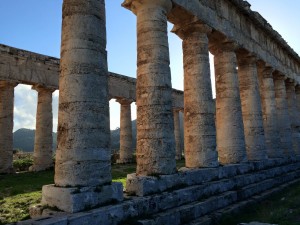Hey guys! Hope you had an excellent time at Segesta and everywhere else; have you tried some granita yet? or some arancini?(they’re fried risotto balls, for those of you who have never heard of em). Speaking of Segesta, here’s a pic of the Segestan temple that I took last fall:

Segesta, as you guys probably have all heard, is an interesting site. The Segestans who constructed this temple seem to have admired a lot of architectural similarity to sites on mainland Italy, such as Paestum. There also has been a lot of ink spilled as to what their relationship might have been with the invading Greeks. The majority of scholars, however, seem to agree that there was a fairly stable alliance. The main temple itself at Segesta also has the same architectural elements as most ____ temples, such as undecorated capitals. Thus, what kind of temple is this? That’s right! Doric, nice job! However, as you might remember from mine and Julianna’s presentation, this temple is a little weird. It’s unfinished because you can’t see the fluting on the columns, as I think Gib noted during our presentation. The reason for its being unfinished is a tad mysterious, but it’s likely that the temple merely “served as a Hellenizing decorative element”, situated around an “open air altar” (Burford 87). Another mysterious artifact in southern Italy, another day out of the trip. Perhaps next post, I’ll talk about something with more concrete conclusions, but I haven’t made up my mind yet. See you for the next post!
Works Cited:
Burford, Alison. “Temple Building at Segesta”. The Classical Quarterly 11.1 (1961): 87–93. Web.
Class notes from Centro trip lecture byProfessors Fagan, Hu, Panciera, and Lieberman. October 2016.